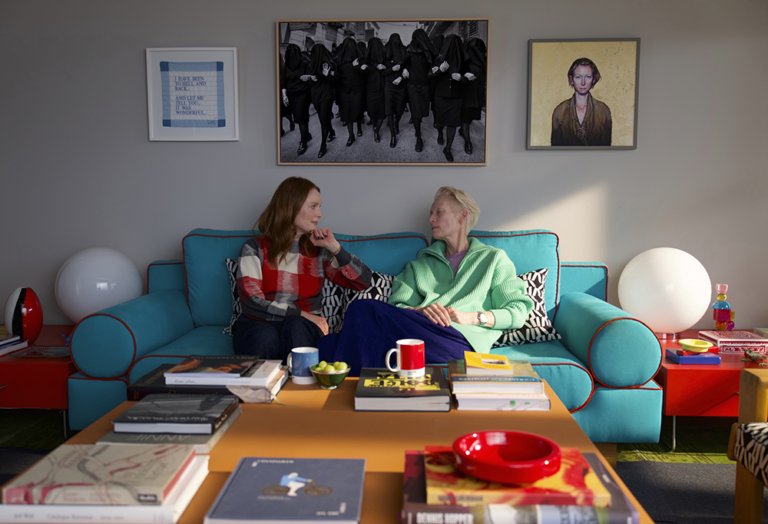Pedro Almodóvar’s elegant and animated artistic vision colors death in bright reds and jagged purples, turning “The Room Next Door” from a meditation to a celebration, propelled by the asymmetric brilliance of Julianne Moore and Tilda Swinton. Adapting Sigrid Nunez’s potent and poignant “What Are You Going Through,” Almodóvar’s film was the Centerpiece selection at the New York Film Festival, marking the director’s fifteenth NYFF selection, of which a record nine have been gala presentations. And while the stellar production design oozes Almodóvar’s grace and flair, Moore and Swinton are indelible, depicting two friends linked by an extraordinary commitment to each other, developing and nursing a bond that flourishes as mortality looms in the foreground.
Ingrid (Moore) is a successful, New York-based writer of autofiction, who finds out through a mutual friend that her old pal Martha (Swinton), a war journalist, is losing a fight with late-stage cancer. While no longer as close as they once were, the two friends catch up quickly when Ingrid visits Martha at the hospital, flowing back into conversation about life, family, and career. So close were these two, that they even shared a man: Damian Cunningham (John Turturro), who Ingrid still confides in—a secret she doesn’t disclose until later. In that initial meeting, Ingrid and Martha move past the reasons why they hadn’t spoken, and cut to the chase of Martha’s agonizing routine: experimental cancer treatments, chemo brain, silence from her only daughter Michelle. Smiling, fitfully optimistic Ingrid bats away what she sees as Martha’s defeatism, reasoning that these days, there’s always hope, giving up is unacceptable.
Leaving No Ambiguity on Almodóvar’s Themes
But what Martha will eventually relay, in a pulsating monologue plucked directly from Nunez’s novel, is that she intends to show bravery and fight back in her own way. Martha found a pill on the “dark web,” and decided that she’d take it; the treatments weren’t working, her body wilting and she refuses to suffer out her dying days while, some vigor remained. So, in the cafe of Alice Tully Hall at Lincoln Center (Almodóvar’s tribute to the festival that has been so supportive of his career), Martha asks Ingrid to be in the room next door when she takes the pill. It lightens the mood a bit when Martha says Ingrid wasn’t her first choice—three friends already said no—and soon, they are in a car on the road to a glorious Airbnb (actually located in Madrid), where Martha will spend an unspecified number of remaining days.
Almodóvar leaves no ambiguity about whose side—friendship and the freedom to choose—he’s on here. And the vibrant production design emphasizes both how the rooms look on the inside (farmhouse-chic, stunning floor-to-ceiling wall candy) and what their world looks like to us. Several sequences are filmed, at first, from the outside through windows, a voyeuristic effect that permits us only to bear witness. The audience becomes a transient third wheel, peering at the two friends at first from a distance, then waiting patiently for an invitation to move closer. When Ingrid visits Martha’s stunning New York rental (“It’s a friend’s place, so I barely pay rent”), the camera rolls from top down, situating the two friends perfectly in the middle, face to face on a couch, silently earning and rewarding each other’s attention. It almost felt invasive to peek, but it’s impossible not to eavesdrop on Moore and Swinton.
Natural, Nuanced Performances from Moore and Swinton

Shot by cinematographer Eduard Grau (“Passing”), the visual beauty never overpowers the human element on screen. And with Moore and Swinton (and Turturro, splendid as the truth-telling academic and former cad Damian), how could it? Long-time Almodóvar collaborator Alberto Iglesias composed a score which delicately builds tension, and unwinds with grace and dignity, mirroring Martha’s meticulous and clear-eyed planning for her own finale. The music is a complement, never a conceit to manipulate the mood or elicit sympathy, and it serves as a eulogy for the friendship and Martha’s memory while the credits roll. In a reverse of “The Hours” (2002), Moore’s character hosts a mourning family member, and it’s only a moderate jolt to see Swinton—playing mother and daughter, yet again—a final time.
Moore and Swinton are both so natural, it’s tempting to call their performances effortless. But, the opposite is true. The caring, tender world these friends share seems like it had to be grounded in reality, love and trust accumulating after years of life, loss and resolution. The way their partnership develops, inevitable distance from estrangement collapses and contracts, until it’s unclear where Martha ends and Ingrid begins. When Ingrid refuses to accept Martha’s wishes, she’s telling us more about her own fears than what she wants—or who she can be—for Martha. Late Almodóvar is softer in tone aside his earlier melodramas (besides some heightened Martha mannerisms and a slightly jarring, Sirkian flashback), but the subject matter and delivery are arguably more provocative. It’s a searching, searing film, anchored by living legends who have met their equals on screen, an enchanting match made in Almodóvarian heaven.
“The Room Next Door” screened at the New York Film Festival, which runs from September 27th – October 14th. Follow us for more coverage.



